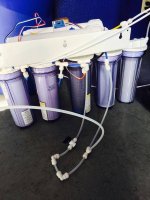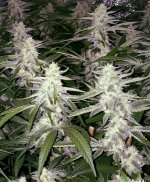Pulsar
Member
QUOTE=theother;6730840]Didn't have a chance to read it all but I will clarify' I don't think I was clear in the last post. Tds creep is happening because an ro is cycling on and off very regularly. The lamps make the water evap the ATO float goes down and the ro starts making water. Happens often and makes small amounts of water. The tds creep is pumped into the do resin depleting it faster.
Your understanding of what is happening is correct, however, who said anything about DI only being affected? This affects every stage.DI just happens to be the most expensive of the bunch.
Ours is different because we pull out 200 gallons and make 200 gallons. No on and off cycling in most hydro systems I have seen. If you did have a float set up to top off a hydro system as the plants drink it you would get tds creep. We of course will get tds creep while the system is off, and that first 1/2 gallon will have a higher tds than the rest, but it will be diluted by the next 200 gallons of water.
The way youre making water is the better way, for sure, but I assure you, not everybody is doing it this way. There are lots of guys plumbing their units straight into their Reservoirs to replace Evap and water loss from Plant uptake.
That's all I'm saying, the tds creep is caused by small volumes of water frequently coming out of the membrane. Hydro (at least in the sense we are all talking about) doesn't work this way.
I dont recall ever discussing specific methods of Hydro in this discussion. Weve just been discussing RO units and membranes/media. I would disagree with the statement that "Hydro doesnt work this way." It entirely depends on the method of hydro dude. For example, say you make a large batch of water for a large DWC operation. Any expert DWC grower will automate their water level replenishment to avoid too large of a PPM spike when the water level drops. Thats an entire other discussion, but theres not always going to be a symbiotic relationship between salts and water level based on what the plants are using. There are plenty of growers, who for convenience sake, are teeing off a water line from their main, straight into their RO unit, and then plumbing that to a float in their DWC Res. Sure, they have automated their Top-off, but theyre burning through their media/membranes. Other more amateur growers are simply topping off by hand. This can be done of course, but its a pain in the ass, it drastically increases the workload, and your system isnt nearly as dialed and stable as it could be.
If your saying the tds creep that is occurring while the float valve is off is ruining the membrane than I apologize. So far everything I have been able to find about it refers to it depleting the di resin faster because it's getting that first 1/2 gallon of less than perfect ro pushed though it and that is the concern.
"Less than perfect" is a generous statement. Youre correct, but youre(not you literally) are blasting short bursts of exponentially higher TDS through your media and membranes. If by "less than perfect," you mean "extremely damaging," then agreed.
We don't use di as a last stage filter, and even if we did it would be only that first 1/2 gallon./QUOTE
Just depends on who you mean by "We". The proverbial "We," as in the entire Hydro community? I understand that most in the Hydro world arent running DI, but theres no reason why they shouldnt. An extra housing can be added to almost any existing RO unit for like $40. I should mention that I used to run Hardwater Tap in Hydro with good results, so none of this is critical, or necessary for the average grower. Thats not what Im claiming. But my end product quality in DWC skyrocketed after starting with pure water.
Your understanding of what is happening is correct, however, who said anything about DI only being affected? This affects every stage.DI just happens to be the most expensive of the bunch.
Ours is different because we pull out 200 gallons and make 200 gallons. No on and off cycling in most hydro systems I have seen. If you did have a float set up to top off a hydro system as the plants drink it you would get tds creep. We of course will get tds creep while the system is off, and that first 1/2 gallon will have a higher tds than the rest, but it will be diluted by the next 200 gallons of water.
The way youre making water is the better way, for sure, but I assure you, not everybody is doing it this way. There are lots of guys plumbing their units straight into their Reservoirs to replace Evap and water loss from Plant uptake.
That's all I'm saying, the tds creep is caused by small volumes of water frequently coming out of the membrane. Hydro (at least in the sense we are all talking about) doesn't work this way.
I dont recall ever discussing specific methods of Hydro in this discussion. Weve just been discussing RO units and membranes/media. I would disagree with the statement that "Hydro doesnt work this way." It entirely depends on the method of hydro dude. For example, say you make a large batch of water for a large DWC operation. Any expert DWC grower will automate their water level replenishment to avoid too large of a PPM spike when the water level drops. Thats an entire other discussion, but theres not always going to be a symbiotic relationship between salts and water level based on what the plants are using. There are plenty of growers, who for convenience sake, are teeing off a water line from their main, straight into their RO unit, and then plumbing that to a float in their DWC Res. Sure, they have automated their Top-off, but theyre burning through their media/membranes. Other more amateur growers are simply topping off by hand. This can be done of course, but its a pain in the ass, it drastically increases the workload, and your system isnt nearly as dialed and stable as it could be.
If your saying the tds creep that is occurring while the float valve is off is ruining the membrane than I apologize. So far everything I have been able to find about it refers to it depleting the di resin faster because it's getting that first 1/2 gallon of less than perfect ro pushed though it and that is the concern.
"Less than perfect" is a generous statement. Youre correct, but youre(not you literally) are blasting short bursts of exponentially higher TDS through your media and membranes. If by "less than perfect," you mean "extremely damaging," then agreed.
We don't use di as a last stage filter, and even if we did it would be only that first 1/2 gallon./QUOTE
Just depends on who you mean by "We". The proverbial "We," as in the entire Hydro community? I understand that most in the Hydro world arent running DI, but theres no reason why they shouldnt. An extra housing can be added to almost any existing RO unit for like $40. I should mention that I used to run Hardwater Tap in Hydro with good results, so none of this is critical, or necessary for the average grower. Thats not what Im claiming. But my end product quality in DWC skyrocketed after starting with pure water.
Last edited:

 that's what's up with hydro my friend
that's what's up with hydro my friend 


